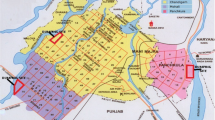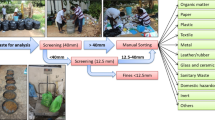Abstract
Municipal solid waste (MSW) management is the most challenging environmental issue in developing countries around global municipalities. In mountainous regions, very few studies can be found and the availability of limited data, because waste management poses different challenges due to different climate, topography, and geographical conditions. This study has been conducted in three urban areas of the Kashmir region (i.e., Baramulla, Kupwara, and Bandipora) in the western Himalayas. Presently, waste management is underdeveloped and openly dumped in an unscientific manner near to the rivers, streams, and lakes, which increases the threat of contamination to ground and surface water, respectively. The present study aimed to analyze the current scenario of the MSW management system and its waste generation rates. The Physio-chemical characterization of municipal solid waste was carried out by using a quarter and cone method. Proximate analysis of samples was performed by using muffle furnace and bomb calorimeter for chemical analysis, respectively. The findings of the MSW generation of urban areas of Kashmir were approximately 181.43 Mt/day (93.73 Mt/day in Baramulla, 57.46 Mt/day in Kupwara, and 30.27 Mt/day in Bandipora), respectively. Further, the findings of MSW showed high organic waste between (10.3%–68.5%), followed by recyclable waste (12.3%–15.30%), and inert waste (8.27%—9.10%), respectively. Also, the chemical characterization results showed average moisture content varying between (47.6%–52.40%) with the lower calorific values of (1017–1175.6 kcal/kg) in the areas mentioned earlier. In conclusion, alternative treatment methods were proposed, for instance, compositing, biomethane plants, the installation of recycling plants, and upgrading the existing dumping sites to sanitary-engineered landfills.


Source: Field survey)

Source: Field survey)

Similar content being viewed by others
Explore related subjects
Discover the latest articles and news from researchers in related subjects, suggested using machine learning.References
United Nations Report. Sustainable mountain development report of the secretary-general summary. 2016. 13187;1–20. https://www.fao.org/mountain-partnership/our-work/advocacy/un-secretary-generals-report-on-mountains/en/. Accessed 28 Aug 2019.
Annepu RK. Sustainable solid waste management in India. MS Dissertation, Columbia University, 2012. pp. 1–189. https://doi.org/10.1007/978-981-4451-73-4.
Nabavi-Pelesaraei A, Bayat R, Hosseinzadeh-Bandbafha H, et al. Prognostication of energy use and environmental impacts for recycle system of municipal solid waste management. J Clean Prod. 2017;154:602–13. https://doi.org/10.1016/j.jclepro.2017.04.033.
Semernya L, Ramola A, Alfthan B. Waste management outlook for mountain regions: sources and solutions. 2017. https://wedocs.unep.org/handle/20.500.11822/16794. Accessed 28 Aug 2019.
Municipal solid waste management manual-Part I: an overview. Minist Urban Dev. 2016;1:62. https://swachhbharatmission.gov.in/sbmcms/index.htm. Accessed 29 Aug 2019.
Dube R, Nandan V, Gudipudi R. Sustainable MSWM in Indian Cities—challenges and opportunities. GTZ-ASEM (Advisory Serv Environment Management). 2010. https://www.iswa.org/uploads/tx_iswaknowledgebase/Dube.pdf. Accessed 1 Sept 2019.
Das D, Srinivasu M, Bandyopadhyay M. Solid state acidification of vegetable waste. Indian J Environ Health. 2018;40:333–42.
Kumar S, Bhattacharyya JK, Vaidya AN. Assessment of the status of municipal solid waste management in metro cities, state capitals, class I cities, and class II towns in India: an insight. Waste Manage. 2009;29:883–95. https://doi.org/10.1016/j.wasman.2008.04.011.
Adhya TK, Sapkota T, Swamy M. An analysis of the trends of GHG emissions in India. In: GHG Platform India. 2016. pp. 3–35. https://shaktifoundation.in/wp-content/uploads/2017/06/Vasudha-Foundation-USA-Inc-2016-An-analysis-of-the-trends-of-GHG-emissions-in-India.pdf. Accessed 1 Sept 2019.
Report ES. Directorate of economics & statistics (Jammu and Kashmir). India: Government of Jammu & Kashmir, 2017. pp. 1–329. http://ecostatjk.nic.in/digeststat/PDF%20for%20website%202016-17.pdf. Accessed 25 Aug 2019.
Punmia BC, Jain AK, Jain AK. Environmental engineering-I, water supply engineering. New Delhi, India: Laxmi Publications; 2005.
Batool SA, Chaudhry MN. Municipal solid waste management in Lahore City District, Pakistan. Waste Manag. 2009;29:1971–1981. https://doi.org/10.1016/j.wasman.2008.12.016.
Manual T. Developing integrated solid waste management plan, vol 1: waste characterization and quantification with projections for future. United Nations Environ Program. 2009. pp. 1–77. https://wedocs.unep.org/bitstream/handle/20.500.11822/7502/ISWMPlan_Vol1.pdf?sequence=3. Accessed 6 Sept 2019.
ASTM D5231-92. Standard test method for determination of the composition of unprocessed municipal solid waste, ASTM International, West Conshohocken, PA. 2016. https://doi.org/10.1520/D5231-92R16.
Riber C, Petersen C, Christensen TH. Chemical composition of material fractions in Danish household waste. Waste Manage. 2008;29:1251–7. https://doi.org/10.1016/j.wasman.2008.09.013.
Shah MA, Khan MNS, Kumar V. Biomass residue characterization for their potential application as biofuels. J Therm Anal Calorim. 2018;134:2137–45. https://doi.org/10.1007/s10973-018-7560-9.
ASTM D5865 / D5865M-19, Standard test method for gross calorific value of coal and coke, ASTM International, West Conshohocken, PA. 2019. https://www.astm.org/Standards/D5865.html. Accessed 27 Dec 2019.
Hoornweg D, Thomas L. What a waste: solid waste management in Asia Urban Development Sector Unit East Asia and Pacific Region. Washington DC, USA: The World Bank; 1999.
SWM Rules. Municipal solid waste management manual-part II. Ministry of Urban Development. 2016;3:604. https://swachhbharatmission.gov.in/sbmcms/index.htm. Accessed 4 Sept 2019.
Zhu D, Asnani PU, Zurbrugg C. Improving municipal solid waste management in India: A sourcebook for policymakers and practitioners. The World Bank. 2007. https://openknowledge.worldbank.org/handle/10986/6916. Accessed 26 Aug 2019.
Duru RU, Ikpeama EE, Ibekwe JA. Challenges and prospects of plastic waste management in Nigeria. Waste Dispos Sustain Energy. 2019;1:117–26. https://doi.org/10.1007/s42768-019-00010-2.
Emission Report. Emission inventory of CO2 in Jammu and Kashmir – A Sectoral Analysis, vol. 1. Dep Ecol Environ Remote Sensing, J&K, India. 2016. pp. 1–102. http://www.jkdears.com/eers/pdf/co2%20final.pdf. Accessed 26 Aug 2019.
USDA. Soil infiltration rates. Sacramento Cty Board Superv. 1990. https://prod.nrcs.usda.gov/Internet/FSE_DOCUMENTS/nrcs144p2_068436.pdf. Accessed 27 Aug 2019.
Al-Yaqout AF, Koushki PA, Hamoda MF. Public opinion and siting solid waste landfills in Kuwait. Resour Conserv Recycl. 2002;35:215–27. https://doi.org/10.1016/S0921-3449(01)00111-2.
Pires A, Martinho G. Sustainable solid waste collection and management. Bern: Springer International Publishing; 2019.
Nabavi-Pelesaraei A, Bayat R, Hosseinzadeh-Bandbafha H, et al. Modelling of energy consumption and environmental life cycle assessment for incineration and landfill systems of municipal solid waste management—a case study in Tehran Metropolis of Iran. J Clean Prod. 2017;148:427–40. https://doi.org/10.1016/j.jclepro.2017.01.172.
Brunner CR. Incineration technologies. 2nd ed. Oxford: McGraw-Hill; 2004.
Pokhrel D, Viraraghavan T. Municipal solid waste management in Nepal: practices and challenges. Waste Manage. 2005;25:555–62. https://doi.org/10.1016/j.wasman.2005.01.020.
Khajuria A, Yamamoto Y, Morioka T. Estimation of municipal solid waste generation and landfill area in Asian developing countries. J Environ Biol. 2010;31:649–54.
Macrae G. Solid waste management in tropical Asia: What can we learn from Bali? Waste Manag Res. 2012;30:72–9. https://doi.org/10.1177/0734242X10386138.
Sujauddin M, Huda SM, Hoque AR. Household solid waste characteristics and management in Chittagong. Bangladesh Waste Manage. 2008;28:1688–95. https://doi.org/10.1016/j.wasman.2007.06.013.
Kaza S, Yao L, Bhada-Tata P, et al. What a Waste 2.0: a global snapshot of solid waste management to 2050. The World Bank; 2018. pp. 1–296. https://openknowledge.worldbank.org/handle/10986/30317.
Bhat RA, Nazir R, Ashraf S. Municipal solid waste generation rates and its management at Yusmarg forest ecosystem, a tourist resort in Kashmir. Waste Manag Res. 2014;32:165–9. https://doi.org/10.1177/0734242X13518089.
Gupta S, Mohan K, Prasad R. Solid waste management in India: options and opportunities. Resour Conserv Recycle. 1998;24:137–54. https://doi.org/10.1016/S0921-3449(98)00033-0.
Ramakrishna V, Subrahmanyam CN, Bhanuchand S. Municipal solid waste quantification, characterization and management in Mylavaram. IOSR J Mech Civ Eng. 2016;13:77–87. https://doi.org/10.9790/1684-1305047787.
Nabavi-Pelesaraei A, Kaab A, Hosseini-Fashami F et al. Life cycle assessment (LCA) approach to evaluate different waste management opportunities. Adv Waste Energy Technol. 2019;195–216. https://doi.org/10.1201/9780429423376-12.
Acknowledgements
The authors are very thankful to the institute administration and department of Chemical Engineering, National Institute of Technology, Srinagar, for analyzing the Municipal Solid waste samples. The authors are also thankful to the Department of Civil Engineering, Jamia Millia Islamia, New Delhi, and Department of Civil Engineering, National Institute of Technology, Srinagar, Jammu and Kashmir, India.
Author information
Authors and Affiliations
Corresponding author
Ethics declarations
Conflict of interest
On behalf of all authors, the corresponding author submits that there is no conflict of interest.
Additional information
Publisher's Note
Springer Nature remains neutral with regard to jurisdictional claims in published maps and institutional affiliations.
Rights and permissions
About this article
Cite this article
Mushtaq, J., Dar, A.Q. & Ahsan, N. Physio-chemical characterization of municipal solid waste and its management in high-altitude urban areas of North-Western Himalayas. Waste Dispos. Sustain. Energy 2, 151–160 (2020). https://doi.org/10.1007/s42768-020-00040-1
Received:
Revised:
Accepted:
Published:
Issue Date:
DOI: https://doi.org/10.1007/s42768-020-00040-1




